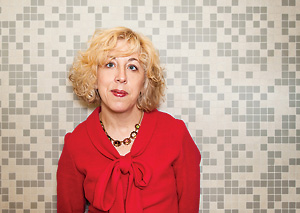Amanda Krugliak stood in a wing of the Detroit Institute of Arts in November 2009 to perform a monologue from her collection “Swoon and Drench.” The piece was an autobiographical account of her return to Ann Arbor after 12 years away. Surrounded by abstract expressionist paintings and standing before the crowd, Krugliak recounted how it felt to be back in her college town.
“When I came back here, the odd sensation that I had was that I was literally running into some former version of myself,” Krugliak says. “I can even remember walking through the Diag, seeing somebody pass me and doing a double take thinking, ‘Was that girl me?’ That made me rethink many things, especially time.”

Photo by Austin Thomason, U-M Photo Services.
Krugliak, who is arts curator for the Institute for the Humanities, studied art and creative writing at U-M and graduated in 1985. She then moved to San Francisco to pursue her dream of being a painter, and began writing down personal stories that came to mind while in the studio.
Surrounded by performance artists and musician friends, Krugliak realized she wanted to take her stories to the stage, and had her first show in 1990. She performed in venues all around San Francisco and once opened for popular ’80s singer Cyndi Lauper.
Krugliak says she had never anticipated coming back to Ann Arbor, but did so in 2002 when her now ex-husband wanted to earn his doctorate U-M. She initially did freelance work for the Institute for the Humanities. Soon after, she reconnected with the School of Art & Design and became an adjunct there, teaching a class about time and time-based art. Two years ago she took on her current position with the Institute and has worked full time since the fall.
As arts curator, Krugliak runs the Institute for the Humanities Gallery, commissioning artists and hosting their works, installing shows, and acting as a liaison between artists and the U-M community. She’s currently developing an initiative to implement the gallery as a teaching tool where undergraduates would get to see the works, and meet the artist or curator to spark a discussion or fuel their own creative processes.
Krugliak’s most memorable day on the job was installing a collaborative project between photographer Richard Barnes and the Museum of Paleontology. They brought a full size cast of a prehistoric whale from the paleontology lab in the basement of the Exhibit Museum of Natural History to the Institute for the Humanities Gallery and caught the attention of students moving into the dorms and people passing by.
“This thing was like a Pied Piper parading down the street. It was fantastic,” Krugliak says. “Everyone’s moving in and here we are in lab coats with this whale being wheeled down Thayer Street. We got to the gallery and it was too big to fit through the door.”
Krugliak says she enjoys working at the gallery, and that she gets back creative energy through collaboration with other artists. It’s important to stay connected to the art community to renew her artistic process and also to give back, she says.
Krugliak’s work also allows her to expose her children, Bruno and Ella, to different experiences, including holding a dinosaur bone from the Museum of Paleontology.
“They think (my job) is really interesting,” she says. “They get to meet fascinating people. They’re exposed to a lot of ways of looking at and talking about things.”
Through her journey into, out of and back to Ann Arbor, Krugliak says her unexpected path has helped her evolve as an artist and better define her sense of self and how she sees the world.
“I love where I’ve landed,” Krugliak says. “Perhaps I don’t know what’s coming next, and I never expected to find myself back here, but I have a sense of what matters. What I’m doing is meaningful to me, and resonates, hopefully to others as well. And that makes me happy.”
The weekly Spotlight features staff members at the university. To nominate a candidate, please contact the Record staff at [email protected].

